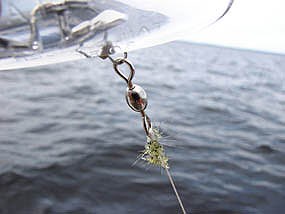
Voyageurs National Park aims to protect interior lakes from exotic species and fish diseaseExotic species such as the spiny water flea rusty crayfish, zebra mussel, and fish diseases are threats to the aquatic ecosystems of regional lakes including those in Voyageurs National Park. Spiny water fleas have recently invaded multiple lakes in the region, including the large lakes within Voyageurs National Park. Rusty crayfish have invaded at least one lake in Voyageurs National Park and many lakes in the region. Zebra Mussel were first detected in the fall of 2021 in Black Bay of Rainy Lake. Viral hemorrhagic septicemia (VHS), a fish disease, has not yet been introduced into any lakes in Minnesota, but has caused fish kills in most of the Great Lakes and in some inland lakes in Michigan and Wisconsin. The National Park Service and DNR are working in concert to prevent the spread of the aquatic invasive species and fish diseases by:
The National Park Service has adopted the following three interim measures to protect the interior lakes in Voyageurs National Park from exotic species and fish diseases:
If you plan to recreate on the interior lakes in Voyageurs National Park, please follow these best management practices:
The park will conduct a program about exotic species and the fish disease (viral hemorrhagic septicemia, or VHS) for any interested party or organization. To schedule a program call Kate Severson at 218-283-6670 or e-mail us. With your help and careful actions, we can try to prevent the spread of zebra mussels, the spiny water flea, rusty crayfish, other invasive species, and fish diseases. Stop aquatic hitchhikers crossing from Rainy Lake to Namakan. Zebra MusselZebra Mussel Fact SheetWhat’s Happening?
When crossing from Rainy Lake to Namakan Lake:
Yes. The spread of zebra mussels is not inevitable; the Minnesota Department of Natural Resources estimates that less than 4% of lakes in the state are infested with zebra mussels.Preventing the spread of zebra mussels, and other invasive species maintains healthy habitats for native species. Healthy aquatic systems assure the health of native species, including popular sportfish. Follow Established Procedures to Minimize Risk of Transport Clean all visible aquatic plants, zebra mussels, and other prohibited invasive species from watercraft, trailers, and water-related equipment before leaving any water access or shoreland. Drain water-related equipment (boat, ballast tanks, portable bait containers, motor) and drain bilge, livewell and baitwell by removing drain plugs before leaving a water access or shoreline property. Keep drain plugs out and water-draining devices open while transporting watercraft. Dispose of unwanted bait, including minnows, leeches, and worms, in the trash. It is illegal to release bait into a waterbody or release aquatic animals from one waterbody to another. If you want to keep your bait, you must refill the bait container with bottled or tap water. Spray, rinse, dry — Some invasive species are small and difficult to see at the access. To remove or kill them, take one or more of the following precautions before moving to another waterbody, especially after leaving zebra mussel and spiny waterflea infested waters:
* These water temperatures will kill zebra mussels and some other AIS: 120°F for at least 2 minutes; or 140°F for at least 10 seconds. Spiny Water FleaSpiny water fleas can be found in many Minnesota lakes including the 4 main lakes of Voyageurs Naitonal Park. They are tiny (1/4-5/8") crustacean zooplankton native to Eurasia and were introduced into the Great Lakes from the ballast water of ships. They threaten the park's aquatic ecosystems and fishing by competing with native fish for food and fouling fishing gear. Research has shown that the spiny water flea can cause the following impacts: · change the community composition of zooplankton · compete directly with juvenile yellow perch and other small fish and minnows for food which could lead to a decrease in the abundance of these fish These impacts could alter the food web; for instance, yellow perch are an important part of the diet of walleye, so a decrease in yellow perch abundance could hurt walleye growth. Rusty Crayfish Rusty crayfish are native to the Ohio River drainage but have invaded lakes in Wisconsin and Minnesota in recent years. They were found in Sand Point Lake in 2006. Rusty crayfish are more aggressive than native crayfish and can eliminate native crayfish and aquatic plants, causing great change to the aquatic ecosystem of invaded lakes. Please do not move live crayfish from one lake to another, and remember that it is illegal to use live crayfish for bait in any lake in Voyageurs National Park.
Viral Hemorrhagic Septicemia Viral hemorrhagic septicemia (VHS) is a viral fish disease that has been found in all of the Great Lakes except Lake Superior. It can kill many species of game fish including walleye and muskellunge. It could easily be spread to Minnesota lakes since many people travel between areas with infected lakes and Minnesota, and the virus that causes the disease can be spread by moving infected bait or water to uninfected lakes. Although VHS causes mortality in fish, it is not a threat to human health.
|
Last updated: May 6, 2025
